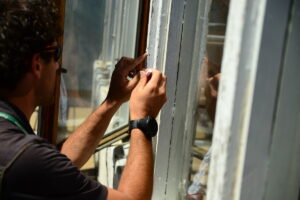Even if you got lead remediation in the past, chances are that either the cleaning wasn’t thorough enough or it doesn’t meet the current stricter safety standards. So, while you may have passed the test previously, currently the acceptable level has been significantly reduced and may not cut it anymore.
Acting quickly helps minimize health risks and ensures you stay compliant with regulations. Once that is done, you’ll need a professional lead inspection in NYC as lead particles are invisible to the naked eye, a visual check won’t be enough.
This blog helps you understand lead clearance and remediation processes. Let’s explore why tests fail, how to address these failures, and how to create a safe, lead-free environment.
Lead Clearance Failure: What to Do and How to Fix It
First things first, don’t panic if your lead clearance fails. You can fix this, but you have to act fast. When a property fails the lead-safe clearance test, the owner has 30 days to take action
Double-Check the Results
First, make sure the inspection results are accurate. Go through the inspection report to see where the lead hazards are. If you’re unsure, get a second opinion from another inspection company. It’s always worth it to double-check.
Find the Source of Lead
Once you know there’s a lead, the next step is to figure out where it’s coming from. Start by looking for peeling or cracked paint, as that’s one of the most common places lead hides. If your house is older, check for lead pipes or plumbing that might be contaminating your drinking water. You can also check other spots like dust, soil, and window wells to see if they’re contaminated too.
Re-clean the Property
Then, have the place re-cleaned. But it’s not something you can or would want to do on your own. This means hiring a certified lead abatement contractor or a qualified professional to come in and take care of it properly.
Get a Follow-Up Lead Inspection
Once that’s done, get a follow-up lead inspection. Just because you cleaned it up doesn’t mean it’s all gone. A professional inspection will check if the space is now safe and compliant with current standards. In the meantime, seal off the areas that failed the test. You can use plastic sheeting or something temporary to keep lead dust from spreading around the house.
Consider Long-Term Solutions
Depending on the situation after the lead inspection in NYC, you may need temporary fixes and permanent solutions. The goal is to reduce lead hazards so your property can pass inspection and get certified as safe. The following are the most common lead remediation techniques for followed after a lead clearance failure.
Interim Controls
Interim controls are quick and practical fixes to reduce lead exposure temporarily. For example, you can repair peeling paint, add liners to window tracks, or install carpets on stairways to minimize lead dust. These methods work well but require regular upkeep to remain effective.
Abatement
Abatement is a long-term solution, often lasting up to 20 years. It involves permanently removing lead hazards, like replacing windows or doors with lead paint or covering large surfaces with durable materials. While abatement can be costly, it provides lasting safety and peace of mind by eliminating lead at its source.
Enclosure
Enclosure creates a physical barrier to seal off lead paint from your living space. For instance, walls can be covered with drywall or window sills with aluminum or vinyl. This avoids direct removal of the lead paint but requires durable materials since any damage to the barrier could expose the lead again.
Encapsulation
Encapsulation seals lead paint under a protective coating, preventing lead dust from being released. It’s like painting over lead paint but with a special bonding agent that creates a strong barrier. Proper application following the manufacturer’s instructions is essential for it to work effectively over time.
Also Read: Lead Safety Tips for Urban Families: Childproofing Your Home
Safe Practices for Lead Remediation
Lead remediation and lead inspection in NYC require strict safety measures to protect workers and residents. Here’s what you should do if you think you, your loved ones, or the workers have been exposed:
- Children and pregnant women should avoid work areas until cleanup is thoroughly completed.
- Sealing off rooms with heavy plastic sheeting prevents dust from spreading to other parts of the house.
- Workers need to wear protective gear, including disposable coveralls, gloves, goggles, and respirators approved by NIOSH or MSHA.
- Eating, drinking, and smoking in work areas should be strictly prohibited to avoid ingesting lead.
- After work, careful cleanup is essential. Workers should vacuum their clothing with a HEPA-filtered vacuum and remove protective wear before leaving the site.
- Showering immediately after leaving the work area minimizes the risk of contaminating homes or other spaces with lead dust.
Lead Clearance Made Simple with Manhattan Lead
Clearing lead hazards takes the right knowledge, careful cleaning, and a solid plan for remediation. Whether you’re a property owner or a contractor, staying on top of safety standards and using effective methods is key to protecting health and meeting regulations.
For trusted lead inspection in NYC, Manhattan Lead is here to help you create a safer, lead-free space you can rely on. We specialize in thorough inspections and offer reliable solutions to all your lead problems. Contact us today to schedule your inspection.




